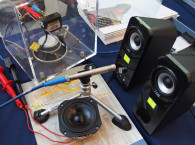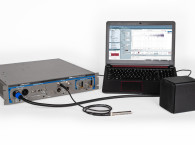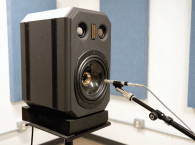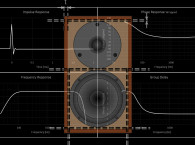
Good news: there is a viable alternative to building a large anechoic chamber when testing loudspeakers and microphones; testing can be done in a reverberant room, and the reverberation can be electronically removed from the measurement results. The process involves time-windowing the impulse response.
In some circumstances, reverberation is required. The proverbial "good acoustics" of concert halls are created through the deliberate use of acoustic elements, which guide the sound waves emitted by the musical instruments to the listener's ear through reflection on different propagation paths. In communication, such as in classrooms, attempts are made to reduce but not completely eliminate the amount of reflections, to improve the intelligibility of speech.
In the case of acoustic measurements for quality testing of microphones or loudspeakers, however, we want to completely avoid reflections, since only the properties of the object under test should be considered - without the reflective influences of the space within which the object is placed for testing. One possible solution is to perform the measurements in a low-reflection room lined with acoustic absorbers. The required thickness of the absorber layer or the length of the porous wedges means that such spaces are large and expensive and are therefore only available to a few acousticians. In practice, quality tests on microphones and loudspeakers tend to take place in small measuring chambers - and therefore the results are, to a large extent, influenced by the environment. Modern signal processing provides a workaround.
Impulse response
In order to be able to eliminate room reflections from the measurement result, the reflections first have to be detected and visualized by measurement. This can be achieved using an impulse response in which a very short, high-amplitude impulse is transmitted. The measurement result shows several impulses: the first impulse represents the direct sound from the loudspeaker to the microphone, while the impulses arriving a short time later describe acoustic detours via reflections on the surfaces of the measuring chamber.

Graphic above: Impulse response in a system with reflections
Graphic below: Frequency response of the system with reflections
GlideSweep
A GlideSweep is a test signal that has been used in modern audio measurement technology for several years. With a GlideSweep, the signal frequency is continuously increased. The start and stop frequency as well as the duration of the sweep are defined. In a linear and time-invariant system (LTI system), as a loudspeaker is considered for this intent and purpose, the impulse response can also be determined after excitation with a GlideSweep. The impulse response serves as the basis for all calculations of measurement results such as the frequency response or distortions. A typical GlideSweep measurement includes these steps:
- Excitation of the object under test with a GlideSweep signal
- Acquisition and digitalization of the analog output signal
- Calculation of the impulse response from the excitation signal and the digitized signal
- Calculation of the desired measurement results from the impulse response
Time windowing of the impulse response
In order to hide the disturbing reflections from the measurement result, a time window is now added after the calculation of the impulse response. The time window ensures that only the main impulse of the impulse response (the direct sound) is used for the further calculation. The reflections arriving after the main pulse are hidden. This requires an additional step in signal processing:
- Excitation of the specimen with a GlideSweep signal
- Acquisition and digitalization of the analog output signal
- Calculation of the impulse response from the excitation signal and the digitized signal
- Time windowing of the impulse response
- Calculation of the desired measurement results from the windowed impulse response

Graphic above: Windowed impulse response
Graphic below: Frequency response of the system without reflections
Effects of time windowing
Since the reflections are no longer included in the calculation of the measurement results, the disturbing ripple disappears and the frequency response appears continuously. However, cutting off the impulse response before the first reflection also removes information that would be needed to fully describe the LTI system. As a result of the windowing, the results below the cutoff frequency f(g) are no longer completely reliable. These frequencies appear in the frequency response as "uncertain". f(g) is calculated from the time t(f) on which the window was set:

In the above example, t(f) is about 210 ms. This results in a limit frequency f(g) of almost 5 Hz, which is not critical for the measurement shown above. In smaller rooms, the reflections arrive sooner, so that the lower limit frequency at a t(f) of 20 ms is already at 50 Hz. From this it can be deduced that speaker and microphone should be placed as far away from reflective surfaces as possible during testing.

These measurements can be performed using NTi Audio's FX100 Audio Analyzer, which ships with the FX-Control Suite, a PC-based software application providing control of and reports from the FX100, pictured above.
See a FX100 product video that shows Anechoic Measurements with the FX100 application.
www.nti-audio.com






